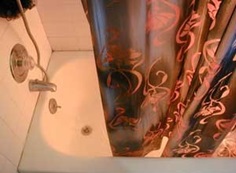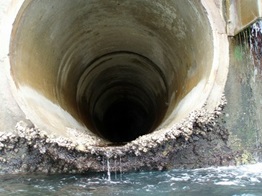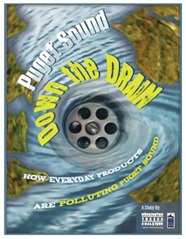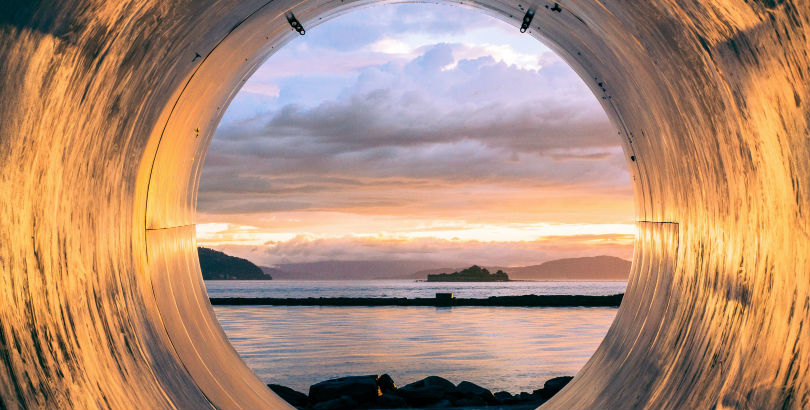Editor’s Note: This is the third installment in a series of posts delving into some of the the chemical pollutants that have contaminated Puget Sound’s fish and wildlife and pose one of the greatest threats to their survival. This is part two of a two-part series that examines phthalate chemicals found in everything from vinyl shower curtains to shampoo.
This post was written by Dr. Fran Solomon, an environmental biologist who teaches courses and gives seminars for university students, environmental and health care professionals, and the general public about toxic chemicals and how they affect human health and the aquatic environment.
Having discovered that phthalates pose an ongoing threat to Puget Sound, state agency scientists have put on their detective hats to pin down the sources. One of the trails has led to polluted runoff: scientists believe that phthalates in plasticized vinyl products off-gas to air, attach to dust and other particles, and are then deposited on hard surfaces such as paved roads, sidewalks, and parking lots. Stormwater picks up the contaminated particles and transports them to lakes, rivers, and Puget Sound. The contaminated particles then settle in the sediments. The higher the percentage of land area with hard surfaces in a watershed, the more phthalates end up in the sediments of associated waterbodies [1].
Sampling has borne this theory out, typically finding six phthalates in sediments where polluted runoff drains into Puget Sound and in stormwater catch basins such as those at the Duwamish River Superfund site. DEHP is usually detected most frequently and at the highest levels [2]. It was detected in 14 of 19 salmon fillet samples collected at this site by the Lower Duwamish Waterway Group [3].
Where Are They Coming From?
P hthalates can also off-gas from disposal sites, consumer products, and burning of plastic products, attach to dust particles or rainfall, and settle directly in Puget Sound and other surface water. When we throw products containing phthalates in the garbage, the products go to a landfill. Phthalates can contaminate sediments in the landfill and ultimately leach into Puget Sound [4,5].
hthalates can also off-gas from disposal sites, consumer products, and burning of plastic products, attach to dust particles or rainfall, and settle directly in Puget Sound and other surface water. When we throw products containing phthalates in the garbage, the products go to a landfill. Phthalates can contaminate sediments in the landfill and ultimately leach into Puget Sound [4,5].
Sewage is another major way phthalates travel to Puget Sound. People are constantly exposed to phthalates, so we excrete them and their breakdown products in our urine. When we apply personal care products to our skin and then wash our hands or take a shower, phthalates in those products are washed down sink drains.

The same is true when we use laundry detergent that contains phthalates. Sink water and laundry water then travel to sewage treatment plants, and although current sewage treatment methods remove many pollutants, they do not totally remove phthalates. The treated sewage, containing phthalates, is then discharged legally to the deep waters of Puget Sound. Levels of DEHP in flows from 15 sewage treatment plants in the Puget Sound region are high enough to exceed State of Washington water quality standards. Every year, a total of 9,363 pounds of DEHP alone are permitted to be discharged from sewage treatment plants in the Puget Sound region [3,6].
Puget Sound Down the Drain

Erika Schreder, a scientist at the Washington Toxics Coalition, and Heather Trim, a scientist at People For Puget Sound, led a fascinating study that showed another pathway for entry of phthalates to sewage.
The study demonstrated for the first time that house dust contaminated with phthalates from everyday consumer products is hitchhiking on our clothes and heading down the drain to Puget Sound via washing machine rinse water. Researchers vacuumed floors and did the laundry, collecting the rinse water from six homes in the Puget Sound region. When dust and laundry rinse water samples were analyzed for phthalates, the researchers found phthalates present in every dust and rinse water sample. Based on the total DEHP load to sewage treatment plants, the study team estimated that about 17.5% of the total load comes from phthalates in everyday consumer products off-gassing and collecting in dust [7].
The Department of Ecology and the Puget Sound Partnership have been struggling to resolve questions of where chemicals like phthalates are coming from and how they are traveling to the Sound. Their thinking: if they can pinpoint the most important sources and transport routes, they can take more effective action. But as they refine their studies, they have increasingly come to the conclusion that prevention is the best answer. Cleaning up Puget Sound means getting chemicals like phthalates at the real source—products that contain them and industries that use them.
Sewer drain courtesy of Flickr user eutrophication&hypozxia
Notes
- Sediment Phthalates Work Group, Summary of Findings and Recommendations. 2007, Prepared by City of Tacoma, City of Seattle, King County, Washington State Department of Ecology, and U.S. Environmental Protection Agency.
- Trim, H., A Hamilton, J Pengilly, L O’Rollins, and A Yost, Toxic Chemicals in Puget Sound: The Impact of Mixing Zones on Permitted Discharges. 2008, People for Puget Sound: Seattle.
- Trim, H., BJ Cummings, E Hulsizer, and K Flint, Phthalates – the next phosphate?, Proceedings of the 2005 Puget Sound Georgia Basin Research Conference, Seattle.
- Agency for Toxic Substances and Disease Registry (ATSDR), Di(2-Ethylhexyl) Phthalate (DEHP) Tox FAQs. Update. 2002, Public Health Service, U.S. Department of Health and Human Services: Atlanta.
- Agency for Toxic Substances and Disease Registry (ATSDR), Toxicological Profile for Di(2-Ethylhexyl) Phthalate (DEHP). 1998, Public Health Service, U.S. Department of Health and Human Services: Atlanta.
- Steinemann, AC, Fragranced consumer products and undisclosed ingredients. Environmental Impact Assessment Review, 2009. 29(1): pp. 32-38.
- Schreder, E. and H Trim, Puget Sound Down the Drain: How Everyday Products are Polluting Puget Sound. 2009, Washington Toxics Coalition and People For Puget Sound: Seattle.




